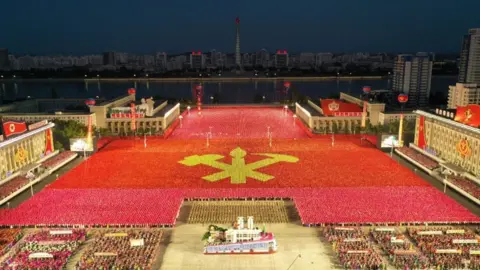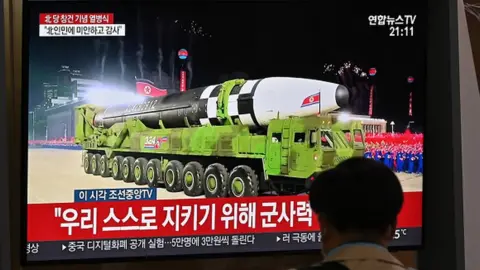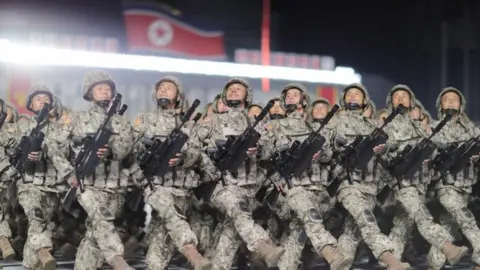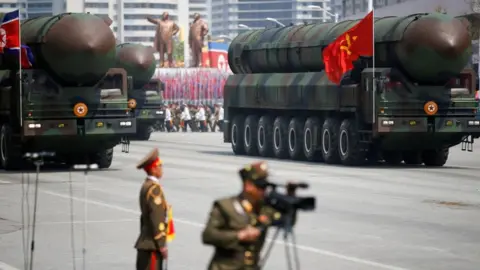North Korea: What we know about the 'massive' new missile on parade
North Korea has unveiled a new ballistic missile whose "colossal" size has surprised even seasoned analysts of the country's arsenal. Defence expert Melissa Hanham explains what the missile is and why it is a threat to the US and the world.
To mark the 75th anniversary of North Korea's ruling Workers' Party, the country threw an unparalleled military parade at the stroke of midnight.
The heavily choreographed event featured all the pomp and circumstance the world has come to expect from North Korea's mass human performances. It also contained a surprisingly emotional speech from Chairman Kim Jong-un, who at times wept as he spoke about the country's struggles.
Last, but certainly not least, it revealed North Korea's largest intercontinental ballistic missile (ICBM) to date.
Here are three things we know about the missile.
 Reuters
ReutersKim's promised 'strategic weapon'
On 1 January 2020, Mr Kim gave his annual New Year's address wherein he announced that North Korea was "developing the state-of-the-art weapons system possessed only by advanced countries".
He specifically referred to a "strategic" - meaning nuclear - weapons system under development.
Mr Kim pointedly tied the weapon to the US, stating "in the future, the more the US stalls for time and hesitates in the settlement of DPRK-US relations, the more helpless it will find itself before the might of the Democratic People's Republic of Korea, which is growing stronger beyond prediction, and the deeper it will fall into an impasse".
This new ICBM is Mr Kim's promised strategic weapon. It absolutely targets the US, and is delivered as a fait accompli in the face of failed negotiations with the Trump administration.
A new threat to US missile defence systems
North Korea already has two tested ICBMs. The Hwasong-14 was tested twice in 2017 and with a range of 10,000km (6,213 miles) can reach nearly all of western Europe and about half of the US mainland carrying a single nuclear warhead.
The Hwasong-15, also tested in 2017, has a range of 13,000km, meaning it can deliver a single nuclear warhead anywhere in the US mainland.
The new ICBM, which has yet to be tested, is also a two-stage liquid-fuelled missile, but with a greater length and diameter than the Hwasong-15.
 Getty Images
Getty ImagesUntil the engines are revealed or a test is carried out, it is unlikely we will know its exact range.
However, the design makes North Korea's intentions very clear: they do not need to increase the range of their missiles anymore.
Instead, they are focusing on trying to launch multiple nuclear warheads on a single missile. This would be yet another blow to the already struggling US missile defence systems, because for each incoming warhead, multiple interceptors need to be launched.
States with advanced nuclear weapons have multiple independent re-entry vehicles - or MIRVs - and now North Korea is seeking to do the same.
An urgent cause for concern
There are several design questions remaining around the ICBM itself, which makes it uncertain when it will be tested or deployed. However, the truck underneath the missile is of immediate concern.
One of the major constraints of North Korea's ability to engage in nuclear warfare is the number of launchers they have. After all, you can only launch as many missiles as you have launchers for.
 Reuters
ReutersThe US estimates that North Korea can launch 12 ICBMs at most. This calculation is based on the hypothesis that each of the six known launchers launch one ICBM and they scramble to quickly launch a second missile before the US retaliates.
In 2010, North Korea illicitly imported six WS51200 heavy-duty trucks from China and modified them with hydraulics to turn them into transporter erector launchers (TELs). These TELs are what North Korea has used to parade, transport and erect their ICBMs.
The trucks are so precious that they drive them away from the missile before launch, because they would be so difficult to replace if there was a missile failure.
This parade represents the first time we have seen more than six trucks in action. These new trucks were modified heavily.
 Getty Images
Getty ImagesIt is therefore clear that North Korea is still able to get components for heavy-duty launchers despite sanctions and export controls. It is also clear that they have built up their manufacturing sector to indigenously modify - and now potentially produce - their own missile launchers.
North Korea's new ICBM, produced in a year of great struggle, is a message to the world not to underestimate the state, its leader, or the technological ability of its people.
Melissa Hanham, an expert on weapons of mass destruction and open source data, is the deputy director of Open Nuclear Network (ONN), a programme of One Earth Future Foundation
